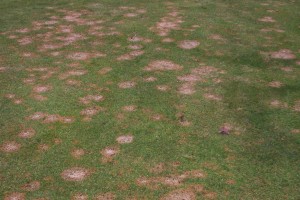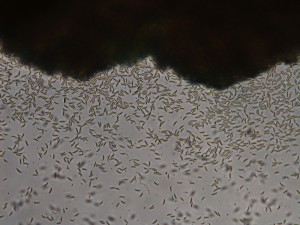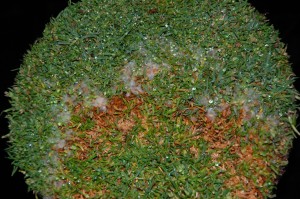The great blizzard of 2013, with all the snow and ice (and hype), has brought concerns about snow mold diseases in turfgrass. First thing first, I am glad I don’t live in Connecticut….40 inches! At any rate, snow cover provides an excellent environment for many fungi including some species of Pythium. In New Jersey we have the fungi Typhula incarnata, which causes the disease gray snow mold, and Microdochium nivale, which is the cause of pink snow mold (AKA: Fusarium patch).
Pink snow mold is much more common in our area because the disease does not need snow to develop. Temperatures in the range of 35oF to- 55oF are ideal for the disease as long as there is plenty of moisture. Cold rainy periods in late winter and early spring are generally best for this disease. Not that we can’t have pink snow mold now, but snow is definitely not necessary. Gray snow mold, on the other hand, strongly depends on snow cover. Typhula incarnata grows during similar conditions as Microdochium nivale – wet periods with temperatures between 35oF to- 45oF – but must be covered in snow for the disease to develop. My experience with gray snow mold is that it takes three or four weeks of snow cover to get any turf damage. The longer the snow cover, the more damage the fungus can do. The damage after a long snow cover can be significant. In fact, after long periods of snow cover, many folks overlook gray snow mold, assuming that the grass was dead simply because it had been covered with snow for so long! The warming trend this week has made quick work of our snow cover here in central-New Jersey. I don’t expect to see any samples of gray snow mold from here with this storm, but another significant snowstorm could come at anytime, so don’t rule it out for the season. Those of you up north, well, just go skiing and forget about your grass for now. Once the snow melts, rake and renovate the damaged areas and get on with the season.
One final note, it is not uncommon for pink snow mold to recur until the middle of May. The causal fungus, Microdochium nivale, is a prolific spore producer. It makes conidia (spores) on an open fruiting structure called a sporodochium. The nature of the fruiting body and the masses of conidia it can produce makes this fungus easy to spread. Those of you managing high value turf areas, like putting greens and tees, should scout areas before mowing, so you don’t mow over active disease. Look for bronze rings and/or silvery patches of dead turf that may (or may not) have white or pinkish mycelial growth around the outside edges. Mowing over active disease will result in large bronze streaks of declining turf on your putting surface.
Lastly, we can’t do much about snow mold outbreaks once it snows, but pink snow mold outbreaks on high value turf areas later this season can be controlled with timely fungicide applications. Apply one of the following materials preceding favorable environmental conditions: Armada, Banner, Chipco 26GT, chlorothalonil, Compass, ConSyst, Disarm, Eagle, Headway, Heritage, Insignia, Instrata, Interface, Medallion, PCNB, Spectro, Tartan, thiophanate‐methyl, Tourney, Trinity, Triton, or vinclozolin per manufacturer’s recommendations. For best results next season, begin fungicide treatments in late‐October/early‐November and then repeat in late‐January if the snow cover recedes. Do not reapply PCNB after mid‐January since this product has a three month residual and can yellow turf during warm (>80F) weather.
As for ice and snow damage and all the other winter problems in turf, check out this publication from Ohio State researcher Dr. Karl Dannenberger on the Global Turf Network website.




